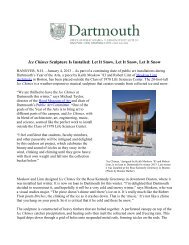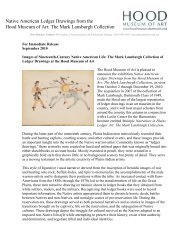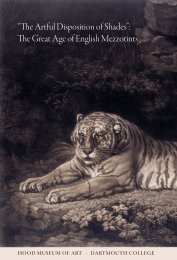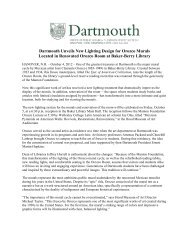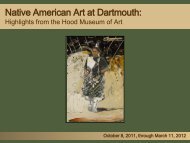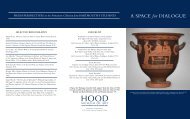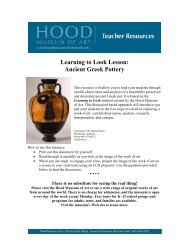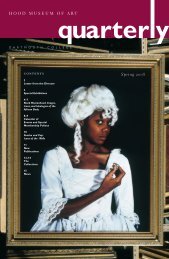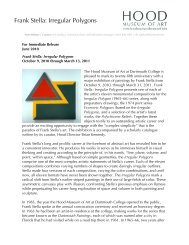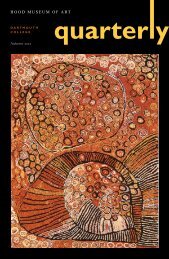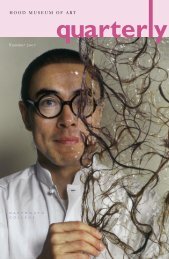Spring 2013 - Hood Museum of Art - Dartmouth College
Spring 2013 - Hood Museum of Art - Dartmouth College
Spring 2013 - Hood Museum of Art - Dartmouth College
- No tags were found...
You also want an ePaper? Increase the reach of your titles
YUMPU automatically turns print PDFs into web optimized ePapers that Google loves.
h o o d m u s e u m o f a r t<br />
quarter y<br />
d a r t m o u t h<br />
c o l l e g e<br />
<strong>Spring</strong> <strong>2013</strong><br />
Hashiguchi Goyo, Woman Applying Powder,<br />
1918, woodblock print. Promised<br />
gift <strong>of</strong> Judith and Joseph Barker,<br />
<strong>Dartmouth</strong> Class <strong>of</strong> 1966.<br />
Photograph by Bruce M. White, 2012
HOOD MUSEUM OF ART STAFF<br />
Letter from the Director<br />
Director Michael Taylor<br />
in front <strong>of</strong> Narputta<br />
Nangala Jugadai’s Murrtja<br />
Kapi, 2003, acrylic on<br />
canvas; promised gift <strong>of</strong><br />
Will Owen and Harvey<br />
Wagner; el.2011.60.42;<br />
on view in the exhibition<br />
Crossing Cultures.<br />
© <strong>2013</strong> <strong>Art</strong>ists Rights<br />
Society (ARS), New York/<br />
VISCOPY, Australia.<br />
The contents <strong>of</strong> this issue <strong>of</strong> the <strong>Hood</strong> Quarterly showcase the pr<strong>of</strong>ound impact that<br />
experiences in the visual arts at <strong>Dartmouth</strong> <strong>College</strong> and the <strong>Hood</strong> <strong>Museum</strong> <strong>of</strong><br />
<strong>Art</strong> have had on undergraduate students. As Joseph Barker, <strong>Dartmouth</strong> Class <strong>of</strong> 1966,<br />
recalls, “It was probably sometime in my junior year at <strong>Dartmouth</strong>, sitting in an art history<br />
class . . . that I first became acquainted with Japanese woodblock prints.” That spark<br />
turned into a lifelong passion for collecting and studying these works. The stunning<br />
collection that he, along with his wife, Judith Liff Barker, has now made a promised gift<br />
to the <strong>Hood</strong> <strong>Museum</strong> <strong>of</strong> <strong>Art</strong> fills a lavish spring/summer exhibition titled The Women<br />
<strong>of</strong> Shin Hanga: The Judith and Joseph Barker Collection <strong>of</strong> Japanese Prints. Curator<br />
Allen Hockley, Associate Pr<strong>of</strong>essor <strong>of</strong> <strong>Art</strong> History at <strong>Dartmouth</strong> <strong>College</strong>, also edited the<br />
sumptuously illustrated catalogue that accompanies the exhibition, which presents new<br />
scholarship and unique insights into the history and technical accomplishment <strong>of</strong> these<br />
magnificent woodblock prints. We wholeheartedly thank Judith and Joseph Barker for<br />
their generosity and commitment to sharing their collection with <strong>Dartmouth</strong>’s students<br />
and faculty, as well as all visitors to the <strong>Hood</strong> <strong>Museum</strong> <strong>of</strong> <strong>Art</strong>, both now and in the future.<br />
Adolph “Bucks” Weil Jr., <strong>Dartmouth</strong> Class <strong>of</strong> 1935, shared his own passion for European<br />
old master prints—which was cultivated during his time at <strong>Dartmouth</strong>—with a<br />
transformative gift <strong>of</strong> works on paper to the <strong>Hood</strong> <strong>Museum</strong> <strong>of</strong> <strong>Art</strong> in 1991. His wife, Jean<br />
Weil, added additional prints by Rembrandt, Lucas van Leyden, Albrecht Dürer, and<br />
many others to that gift in his memory after his death in 1995. We mourn her passing in<br />
August 2012; she and Bucks were the greatest <strong>of</strong> friends to the <strong>Hood</strong> <strong>Museum</strong> <strong>of</strong> <strong>Art</strong>, and<br />
we are honored that their daughter Laurie Weil serves on the <strong>Hood</strong>’s Board <strong>of</strong> Overseers.<br />
The museum is now thrilled to receive Rembrandt’s The Three Trees (1643) and Dürer’s<br />
Saint Jerome in His Study (1514), two <strong>of</strong> the greatest works in the history <strong>of</strong> printmaking,<br />
as a gift from the estate <strong>of</strong> Bucks and Jean Weil. These extraordinary works <strong>of</strong> art are<br />
explored in the “Alumni Voices” section <strong>of</strong> this issue by Stacey Sell, <strong>Dartmouth</strong> Class<br />
<strong>of</strong> 1985, who is the Associate Curator <strong>of</strong> Old Master Prints and Drawings at the National<br />
Gallery <strong>of</strong> <strong>Art</strong> in Washington, D.C. Although Adolph Weil and Joseph Barker graduated<br />
before the <strong>Hood</strong> <strong>Museum</strong> <strong>of</strong> <strong>Art</strong> opened in 1985, they both exemplify our commitment<br />
to the sheer joy <strong>of</strong> studying with original works <strong>of</strong> art, and to the importance <strong>of</strong> this<br />
experience for undergraduate students.<br />
Our dedication to supporting these learning opportunities is evident in three other<br />
exhibitions at the museum this spring. Concurrent with The Women <strong>of</strong> Shin Hanga is an<br />
exquisite exhibition <strong>of</strong> Japanese prints selected from the <strong>Hood</strong>’s collection by students<br />
in Pr<strong>of</strong>essor Hockley’s “Japanese Prints” class. Many <strong>of</strong> these prints were purchased<br />
through the generous support <strong>of</strong> the Carpenter Foundation. Word and Image investigates<br />
the use and significance <strong>of</strong> language in contemporary art and was curated in<br />
collaboration with studio art majors from the Class <strong>of</strong> <strong>2013</strong>. Finally, Alan Covey, Associate<br />
Pr<strong>of</strong>essor <strong>of</strong> Anthropology, selected objects from the <strong>Hood</strong>’s collection with students<br />
enrolled in his winter <strong>2013</strong> class titled “Origins <strong>of</strong> Inequality” that address, as he says,<br />
“material representations <strong>of</strong> inequality” across geography and culture groups. These<br />
exhibitions, together with our ongoing student-curated A Space for Dialogue program,<br />
reflect the <strong>Hood</strong>’s mission to create an ideal learning environment that fosters transformative<br />
encounters with works <strong>of</strong> art.<br />
We very much look forward to welcoming Philip Hanlon, <strong>Dartmouth</strong> Class <strong>of</strong><br />
1977, as the eighteenth President <strong>of</strong> <strong>Dartmouth</strong> <strong>College</strong> and engaging with him on the<br />
museum’s vision for the future, which includes the upcoming expansion <strong>of</strong> our facility<br />
by Tod Williams Billie Tsien Architects. Our strong teaching mission will inform Tod<br />
and Billie’s visionary designs for the new galleries, classrooms, and event spaces, which<br />
will enhance the museum learning experience for all our visitors, and I can’t wait to<br />
share these plans with you in the months ahead. In the meantime, please join us for the<br />
many exciting exhibitions and programs that we have on <strong>of</strong>fer this spring. We are free<br />
and open to all, and I trust that your next visit to the museum will be an enjoyable one.<br />
Michael Taylor<br />
Director<br />
Susan Achenbach, <strong>Art</strong> Handler<br />
Gary Alafat, Security/Buildings Manager<br />
Jonathan Benoit, TMS Project/Digital Asset Manager<br />
Juliette Bianco, Assistant Director<br />
Lindsey Dewar, Assistant to the Director<br />
Patrick Dunfey, Exhibitions Designer/Preparations<br />
Supervisor<br />
Rebecca Fawcett, Registrarial Assistant<br />
Nicole Gilbert, Exhibitions Coordinator<br />
Stephen Gilchrist, Curator <strong>of</strong> Indigenous<br />
Australian <strong>Art</strong><br />
Cynthia Gilliland, Assistant Registrar<br />
Katherine Hart, Associate Director and Barbara C.<br />
and Harvey P. <strong>Hood</strong> 1918 Curator <strong>of</strong> Academic<br />
Programming<br />
Deborah Haynes, Data Manager<br />
Alfredo Jurado, Security Guard<br />
Amelia Kahl, Coordinator <strong>of</strong> Academic Programming<br />
Rebecca Karp, Assistant Curator <strong>of</strong> Education<br />
Adrienne Kermond, Tour Coordinator<br />
Vivian Ladd, <strong>Museum</strong> Educator<br />
Barbara MacAdam, Jonathan L. Cohen Curator <strong>of</strong><br />
American <strong>Art</strong><br />
Nancy McLain, Business Manager<br />
Neely McNulty, Images and <strong>Art</strong>Start Instructor<br />
Nils Nadeau, Communications and Publications<br />
Manager<br />
Allen Newton, Security Guard<br />
Karysa Norris, Curatorial Assistant<br />
Kathleen O’Malley, Associate Registrar<br />
Julie Ann Otis, Development and Membership<br />
Coordinator<br />
Robert Oxman, Security Guard<br />
Alison Palizzolo, Public Relations Assistant<br />
Sarah Powers, Assistant Curator for Special Projects<br />
Sharon Reed, Programs and Events Coordinator<br />
John Reynolds, Lead Preparator<br />
Mary Ellen Rigby, Gift Shop Manager<br />
Margaret Spicer, Adjunct Curator <strong>of</strong> the Henry B.<br />
Williams Costume Collection<br />
Michael Taylor, Director<br />
Sheldon Tefft, Security Guard<br />
Lesley Wellman, <strong>Hood</strong> Foundation Curator<br />
<strong>of</strong> Education<br />
Kathryn Whittaker, Security Guard<br />
Janet Whyte, Security Guard<br />
Amanda Wilson, Office Assistant<br />
Matthew Zayatz, Preparator<br />
<strong>Dartmouth</strong> <strong>College</strong><br />
6 East Wheelock Street<br />
Hanover, New Hampshire 03755<br />
(603) 646-2808<br />
www.hoodmuseum.dartmouth.edu<br />
<strong>Hood</strong> Quarterly #37 (<strong>Spring</strong> <strong>2013</strong>)<br />
Communications and Publications Manager:<br />
Nils Nadeau<br />
Designer: Joanna Bodenweber<br />
Printer: Capital Offset, Inc.<br />
Photos by Jeffrey Nintzel unless indicated otherwise.<br />
© <strong>2013</strong> Trustees <strong>of</strong> <strong>Dartmouth</strong> <strong>College</strong><br />
2
S p e c i a l<br />
exhibitions<br />
The Women <strong>of</strong> Shin Hanga:<br />
The Judith and Joseph Barker Collection <strong>of</strong><br />
Japanese Prints<br />
April 6–July 28, <strong>2013</strong><br />
Torii Kotondo, Morning Hair, 1930, woodblock<br />
print. Promised gift <strong>of</strong> Judith and Joseph Barker,<br />
<strong>Dartmouth</strong> Class <strong>of</strong> 1966.<br />
Photograph by Bruce M. White, 2012<br />
In an attempt to revive traditional Japanese woodblock prints, artists <strong>of</strong> the shin hanga<br />
(new print) movement were forced to reconcile approaches to female subjects developed<br />
over the previous two centuries with the impact <strong>of</strong> modernity on both women<br />
and the arts in early-twentieth-century Japan. To ensure the contemporary relevancy <strong>of</strong><br />
their work, the subjects they depicted ranged between deeply conservative and highly<br />
provocative conceptions <strong>of</strong> femininity, with demure, self-effacing geisha representing the<br />
former, and so-called modern girls, known for their Westernized appearance and morally<br />
suspect lifestyles, representing the latter. By retaining production methods honed<br />
by their predecessors, they cultivated audiences in Japan and America who appreciated<br />
the unique legacies <strong>of</strong> the Japanese woodblock print tradition. These strategies successfully<br />
ensured a place for shin hanga depictions <strong>of</strong> women in an environment where new<br />
print media and styles imported from the West competed with Japan’s most treasured<br />
visual traditions. The results <strong>of</strong> their efforts are amply apparent in this exhibition. With<br />
ninety woodblock prints from the Judith and Joseph Barker Collection, The Women <strong>of</strong><br />
Shin Hanga showcases two and a half centuries <strong>of</strong> Japanese print designers’ engagement<br />
with female subjects. Early prints published between 1767 and 1897 illustrate traditional<br />
approaches to print design and the array <strong>of</strong> technologies shin hanga artists look to as<br />
precedents and models. More than sixty prints by thirteen leading shin hanga artists<br />
document their explorations <strong>of</strong> contemporary female subjects.<br />
This exhibition was organized by the <strong>Hood</strong> <strong>Museum</strong> <strong>of</strong> <strong>Art</strong> and was generously supported by Yoko Otani<br />
Homma and Shunichi Homma M.D., Class <strong>of</strong> 1977, the William B. Jaffe and Evelyn A. Hall Fund, and the<br />
Eleanor Smith Fund.<br />
Word and Image<br />
IN CONTEMPORARY ART<br />
March 26–August 4, <strong>2013</strong><br />
Organized in collaboration with twentyfour<br />
studio art majors from the Class <strong>of</strong><br />
<strong>2013</strong>, this exhibition celebrates the dynamic<br />
dialogue and complex interactions<br />
between art and language in contemporary<br />
art. Adopting a historical perspective<br />
to understand current innovations,<br />
Word and Image presents key examples <strong>of</strong><br />
paintings, sculpture, video, photography,<br />
and other works on paper by a wide<br />
range <strong>of</strong> artists, including Gerald Auten,<br />
Christo, Marcel Duchamp, Robert Gober,<br />
Daniel Heyman, Faith Ringgold, Ed Ruscha,<br />
Nancy Spero, and Fred Wilson. The wordimbued<br />
artworks on display reveal the<br />
strange, unsettling, and <strong>of</strong>ten humorous<br />
and subversive results when words<br />
escape from their traditional confines and<br />
begin to infiltrate the visual arts.<br />
Edward Ruscha, Standard Station, Amarillo, Texas, 1963, oil on canvas. Gift <strong>of</strong> James Meeker, Class <strong>of</strong> 1958,<br />
in memory <strong>of</strong> Lee English, Class <strong>of</strong> 1958, scholar, poet, athlete, and friend to all; P.976.281.<br />
This exhibition was organized by the <strong>Hood</strong> <strong>Museum</strong> <strong>of</strong> <strong>Art</strong> and made possible by the Cissy Patterson Fund and<br />
the Hansen Family Fund.<br />
H O O D Q U A R T E R L Y 3
4 H O O D Q U A R T E R L Y
The Women <strong>of</strong> Shin Hanga<br />
The Judith and Joseph Barker Collection <strong>of</strong> Japanese Prints<br />
Initial encounters with the<br />
prints in this exhibition might<br />
suggest to first-time viewers<br />
that they are little more<br />
than beautifully rendered pictures<br />
<strong>of</strong> fashionable women. Such an<br />
assessment accurately but only<br />
partially characterizes the viewing<br />
experience the artists intended for<br />
them. In early-twentieth-century<br />
Japan, all artists depicting female<br />
subjects strived to strike a balance<br />
between the impact <strong>of</strong> modernity<br />
and the legacies <strong>of</strong> deeply<br />
entrenched cultural values concerning<br />
women and art. This was<br />
especially so for artists <strong>of</strong> the shin<br />
hanga (new print) movement: as<br />
they aspired to carve out a place for<br />
their conception <strong>of</strong> contemporary<br />
female subjects, they were, <strong>of</strong> their<br />
own choosing, bound by precedents<br />
and practices <strong>of</strong> a woodblock-printing<br />
tradition more than<br />
two centuries in the making. Shin<br />
hanga representations <strong>of</strong> women<br />
thus <strong>of</strong>fer an intriguing perspective<br />
on the aesthetics, cultural values,<br />
and social mores <strong>of</strong> a nation and its<br />
artists struggling to reconcile past<br />
and present.<br />
The world inhabited by shin<br />
hanga artists and the women they<br />
depicted was the direct product <strong>of</strong><br />
Japan’s rapid modernization in the<br />
late nineteenth and early twentieth<br />
centuries. Two hundred years <strong>of</strong><br />
self-imposed isolation came to an<br />
end in the mid-1850s, when pressure<br />
from Europe and America<br />
forced Japan to open its ports to<br />
foreign trade. A desire to avoid<br />
colonization at any cost led the<br />
Japanese government to embrace<br />
an aggressive regimen designed to<br />
modernize the nation’s economic,<br />
industrial, military, and social infrastructures.<br />
Victories in wars with<br />
China in the mid-1890s and with<br />
Russia in the mid-1910s suggest that<br />
some aspects <strong>of</strong> the program were<br />
remarkably successful. Reforming<br />
social institutions was far more<br />
complicated, however. In the initial<br />
decades after the opening <strong>of</strong> the<br />
ports, Japan enthusiastically embraced<br />
Euro-American social and<br />
cultural values. Modernization was,<br />
in effect, Westernization. But by the<br />
1880s, conservative intellectuals,<br />
educators, and government <strong>of</strong>ficials<br />
began to question the loss <strong>of</strong><br />
indigenous traditions and national<br />
identity. The roles <strong>of</strong> both women<br />
and the arts in the nation’s social<br />
and cultural fabric were highly<br />
contested as the impact <strong>of</strong> modernization<br />
came under ever-increasing<br />
scrutiny.<br />
The diverse backgrounds <strong>of</strong> the<br />
shin hanga artists in this exhibition<br />
provide telling evidence <strong>of</strong><br />
modernization’s impact on the<br />
arts. <strong>Art</strong> training in pre-modernization<br />
Japan typically came through<br />
master-disciple relationships. Some<br />
shin hanga artists followed this path<br />
by apprenticing with designers <strong>of</strong><br />
traditional prints. Others trained as<br />
typesetters, lithographers, and illustrators<br />
for commercial publishers<br />
or in government ministries before<br />
taking up print design. Many attended<br />
art schools—a distinctly<br />
foreign institution—seeking instruction<br />
in either Western-style or<br />
traditional Japanese painting. The<br />
highly competitive media environment<br />
brought about by modernization<br />
also affected the careers <strong>of</strong><br />
shin hanga artists. None enjoyed<br />
the luxury <strong>of</strong> designing only prints.<br />
Many also worked as illustrators <strong>of</strong><br />
newspapers, magazines, and serialized<br />
novels while others designed<br />
book covers, posters, postcards,<br />
and advertising brochures. Most<br />
pursued highly successful careers<br />
as painters, their works frequently<br />
appearing in prestigious national<br />
exhibitions.<br />
How, then, did tradition and<br />
modernity intersect in shin hanga<br />
depictions <strong>of</strong> female subjects <strong>Art</strong>ists<br />
<strong>of</strong> the shin hanga movement,<br />
from its inception in the mid-1910s<br />
through its demise in the mid-<br />
1950s, devoted their energy and<br />
talents to revitalizing the Japanese<br />
woodblock print tradition that had<br />
waned with the introduction <strong>of</strong><br />
lithography, copperplate engraving,<br />
collotype printing, and photography<br />
from Europe and America.<br />
Shin hanga artists perceived that<br />
traditional print genres retained<br />
their appeal despite Japan’s ongoing<br />
modernization. Kabuki audiences<br />
still sought woodblock-printed<br />
likenesses <strong>of</strong> star actors. Flowerand-bird<br />
images still possessed their<br />
auspicious and seasonal associations.<br />
Rural scenery, rustic villages,<br />
and natural wonders depicted in<br />
traditional landscape prints evoked<br />
feelings <strong>of</strong> nostalgia for a rapidly<br />
urbanizing nation. Similarly,<br />
depictions <strong>of</strong> women lost none<br />
<strong>of</strong> the appeal <strong>of</strong> their pre-modern<br />
antecedents. Like the designers <strong>of</strong><br />
traditional prints, shin hanga artists<br />
understood that contemporary fashions<br />
and social mores appealed as<br />
much to twentieth-century viewers<br />
as they did to their eighteenth- and<br />
Kitano Tsunetomi, Heron Maiden, about 1925, woodblock print. Promised gift <strong>of</strong> Judith and Joseph Barker, <strong>Dartmouth</strong> Class <strong>of</strong> 1966.<br />
Photograph by Bruce M. White, 2012<br />
H O O D Q U A R T E R L Y 5
nineteenth-century counterparts.<br />
Although images <strong>of</strong> contemporary<br />
women were widely available in<br />
new media imported from the<br />
West, shin hanga artists captured<br />
the attention <strong>of</strong> audiences because<br />
they also retained the production<br />
methods used by their predecessors.<br />
The prints in this exhibition<br />
aptly demonstrate the importance<br />
<strong>of</strong> traditional production methods<br />
to shin hanga depictions <strong>of</strong> women.<br />
<strong>Art</strong>ists focused their attention on<br />
hairstyles, cosmetics, clothing, and<br />
fashion accessories, as these were<br />
the most recognizable markers <strong>of</strong><br />
contemporary women. Block carvers<br />
and printers deployed traditional<br />
skills along with new techniques<br />
they developed to replicate<br />
and enhance not just the look <strong>of</strong><br />
these important signifiers, but also<br />
their material and tactile qualities.<br />
Intricately carved and meticulously<br />
printed coiffures <strong>of</strong>ten include hundreds<br />
<strong>of</strong> individual strands <strong>of</strong> hair.<br />
Subtle applications <strong>of</strong> color, carefully<br />
blended with flesh tones, convey<br />
the look <strong>of</strong> cosmetics, lip color,<br />
and eye shadow. Overprinting and<br />
tonal blending capture the deep<br />
hues <strong>of</strong> the natural dyes used for<br />
Japanese fabrics. The combination<br />
<strong>of</strong> fibrous paper, careful manipulation<br />
<strong>of</strong> the baren (the tool used<br />
in hand printing), and embossing<br />
replicates the weight and texture<br />
<strong>of</strong> creped or embroidered cloth.<br />
Ground mica mixed with pigment<br />
highlights the metallic properties <strong>of</strong><br />
jewelry, hair ornaments, and mirrors.<br />
In the competitive media environment<br />
<strong>of</strong> early-twentieth-century<br />
Japan, these traditional production<br />
methods helped distinguish shin<br />
hanga representations <strong>of</strong> women<br />
from those in imported Western<br />
media.<br />
Efforts on the part <strong>of</strong> shin<br />
hanga artists to preserve traditional<br />
subjects and production methods<br />
did not preclude their engagement<br />
with contemporary social<br />
and cultural issues concerning<br />
women. Courtesans from licensed<br />
brothel districts—favorite subjects<br />
for traditional print artists—are not<br />
found in shin hanga because fierce<br />
lobbying by feminists and Christian<br />
Kobayakawa Kiyoshi, Modern Fashions, No. 1 Tipsy, 1930, woodblock print. Promised gift <strong>of</strong><br />
Judith and Joseph Barker, <strong>Dartmouth</strong> Class <strong>of</strong> 1966. Photograph by Bruce M. White, 2012.<br />
groups drove legal prostitution from<br />
the public eye. Shin hanga artists<br />
also chose to avoid women engaged<br />
in new forms <strong>of</strong> unlicensed prostitution<br />
associated with bars, cafés,<br />
and dance halls. The demimonde<br />
is nonetheless well represented in<br />
shin hanga by geisha, whose numbers<br />
grew substantially as women<br />
from impoverished rural districts<br />
flocked to the capital in search <strong>of</strong><br />
employment. Political activists,<br />
feminists, and women authors are<br />
absent from shin hanga despite<br />
their high pr<strong>of</strong>ile in other news and<br />
visual media. Although most <strong>of</strong> the<br />
women appearing in shin hanga<br />
wear traditional garments, have<br />
hair styled in contemporary but<br />
conventional coiffures, and exhibit<br />
the self-effacing attitudes expected<br />
<strong>of</strong> women in polite society, none<br />
represent “good wives and wise<br />
mothers,” the conservative ideal<br />
promoted by educators and government<br />
<strong>of</strong>ficials.<br />
There are notable exceptions<br />
to the general preference shin<br />
hanga artists exhibit for traditional<br />
dress and hairstyles, however.<br />
Distinguished by their bobbed hair<br />
and provocative clothing, “modern<br />
girls” added a distinctly Westernized<br />
subject to the repertoire <strong>of</strong><br />
6 H O O D Q U A R T E R L Y
shin hanga artists. Academics,<br />
newspaper and magazine editors,<br />
and social commentators <strong>of</strong> all<br />
political persuasions regarded the<br />
modern girl as animated, flirtatious,<br />
and promiscuous. Her reputedly<br />
loose morals represented a controversial<br />
departure from the good<br />
wife, wise mother ideology and the<br />
more conventional representations<br />
<strong>of</strong> female subjects in shin hanga.<br />
The female nude—a decidedly<br />
Western conception—is also common<br />
among shin hanga representations<br />
<strong>of</strong> women. Some artists came<br />
to this subject through their training<br />
in Western-style art academies,<br />
where life-drawing <strong>of</strong> nude models<br />
was a part <strong>of</strong> the curriculum. The<br />
women featured in their designs<br />
possess a corporeality not found<br />
in traditional prints. The predominance<br />
<strong>of</strong> scenes depicting nude<br />
women at baths or hot springs, a<br />
subject with iconographic precedents<br />
in traditional prints, reveals<br />
the efforts <strong>of</strong> shin hanga artists to<br />
assert a Japanese rationale for a<br />
subject associated with Western art.<br />
Depictions <strong>of</strong> nude subjects and<br />
the hybrid practices they engendered<br />
reveal shin hanga artists’<br />
engagement with ongoing national<br />
debates concerning representations<br />
<strong>of</strong> women in the arts.<br />
The Women <strong>of</strong> Shin Hanga<br />
presents a selection <strong>of</strong> prints from<br />
the Judith and Joseph Barker Collection<br />
that is uniquely qualified to<br />
explore the tensions between tradition<br />
and modernity in shin hanga<br />
depictions <strong>of</strong> women. Twenty-four<br />
prints published between 1767<br />
and 1897 provide an overview <strong>of</strong><br />
approaches to female subjects by<br />
leading designers <strong>of</strong> traditional<br />
prints working prior to and during<br />
Japan’s rapid modernization in late<br />
1800s. Highlighting presentational<br />
strategies and production methods,<br />
this survey <strong>of</strong> early prints functions<br />
as prelude to the second part <strong>of</strong> the<br />
exhibition, which features sixty-six<br />
prints representing the work <strong>of</strong> shin<br />
hanga’s most notable illustrators<br />
<strong>of</strong> female subjects. Ranging from<br />
conservatively dressed women in<br />
traditional costumes to geisha,<br />
modern girls to nudes, these prints<br />
display the interests, concerns, and<br />
proclivities <strong>of</strong> shin hanga artists and<br />
their audiences. Key block pro<strong>of</strong>s<br />
and multiple editions <strong>of</strong> some<br />
designs in the exhibition expose the<br />
intricate processes <strong>of</strong> shin hanga<br />
production. The pristine quality <strong>of</strong><br />
prints from the Barker Collection<br />
affords a rare opportunity to experience<br />
the technological marvels,<br />
tactile sensibilities, and visual impact<br />
<strong>of</strong> shin hanga while exploring<br />
the contributions <strong>of</strong> this tradition to<br />
early-twentieth-century conceptualizations<br />
<strong>of</strong> Japanese women.<br />
Allen Hockley<br />
Associate Pr<strong>of</strong>essor, Department <strong>of</strong><br />
<strong>Art</strong> History, <strong>Dartmouth</strong> <strong>College</strong>,<br />
and curator <strong>of</strong> the exhibition<br />
This exhibition is on view from April 6 through<br />
July 28, <strong>2013</strong>. It was organized by the <strong>Hood</strong><br />
<strong>Museum</strong> <strong>of</strong> <strong>Art</strong> and generously supported by<br />
Yoko Otani Homma and Shunichi Homma<br />
M.D., Class <strong>of</strong> 1977, the William B. Jaffe and<br />
Evelyn A. Hall Fund, and the Eleanor Smith<br />
Fund.<br />
Ito Shinsui, Woman Wearing an Under Sash, September 1921, woodblock print. Promised gift<br />
<strong>of</strong> Judith and Joseph Barker, <strong>Dartmouth</strong> Class <strong>of</strong> 1966. Photograph by Bruce M. White, 2012.<br />
H O O D Q U A R T E R L Y 7
calendar <strong>of</strong><br />
events<br />
MARCH<br />
30 March, Saturday, 1:00–3:00 p.m.<br />
FAMILY WORKSHOP<br />
<strong>Art</strong> from Africa<br />
Explore sculptures from Africa and discover how these works <strong>of</strong><br />
art play powerful roles in people’s lives. In the studio, we’ll use<br />
mixed media materials to create relief sculptures <strong>of</strong> our own. This<br />
workshop is for children ages 6–10 and their adult companions.<br />
Participation is limited. Please call (603) 646-1469 to register.<br />
APRIL<br />
5 April, Friday, 4:30 p.m.<br />
<strong>Hood</strong> <strong>Museum</strong> <strong>of</strong> <strong>Art</strong> Auditorium<br />
OPENING LECTURE AND RECEPTION<br />
Who Are the Women <strong>of</strong> Shin Hanga<br />
Allen Hockley, Associate Pr<strong>of</strong>essor <strong>of</strong> <strong>Art</strong> History, <strong>Dartmouth</strong><br />
<strong>College</strong>, and curator <strong>of</strong> The Women <strong>of</strong> Shin Hanga: The Judith and<br />
Joseph Barker Collection <strong>of</strong> Japanese Prints<br />
A reception will follow in Kim Gallery. This event is supported<br />
by the <strong>Hood</strong> <strong>Museum</strong> <strong>of</strong> <strong>Art</strong>’s <strong>Museum</strong> Lecture Series Fund.<br />
10 April, Wednesday, 6:30–8:30 p.m.<br />
ADULT WORKSHOP<br />
<strong>Art</strong> and Creative Writing<br />
Try your hand at creative writing in this popular evening workshop.<br />
<strong>Museum</strong> staff will lead participants in a number <strong>of</strong> simple,<br />
evocative writing activities with works <strong>of</strong> art. Writing forms will<br />
include poetry and prose. No previous art or writing experience<br />
is necessary. Participation is limited. Call (603) 646-1469 by April<br />
8 to register.<br />
18 April, Thursday, 12:30 p.m.<br />
LUNCHTIME GALLERY TALK<br />
When Tradition Encounters Modernity<br />
Allen Hockley, Associate Pr<strong>of</strong>essor <strong>of</strong> <strong>Art</strong> History, <strong>Dartmouth</strong><br />
<strong>College</strong>, and curator <strong>of</strong> The Women <strong>of</strong> Shin Hanga: The Judith and<br />
Joseph Barker Collection <strong>of</strong> Japanese Prints<br />
20 April, Saturday, 2:00 p.m.<br />
TOUR<br />
The Women <strong>of</strong> Shin Hanga: The Judith and Joseph Barker<br />
Collection <strong>of</strong> Japanese Prints<br />
24 April, Wednesday, 6:30–8:30 p.m.<br />
ADULT WORKSHOP<br />
Exploring Japanese Woodblock Prints<br />
This discussion-based workshop introduces participants to<br />
the beauty and complexity <strong>of</strong> Japanese woodblock prints. Our<br />
exploration <strong>of</strong> these prints will take us from eighteenth- and<br />
nineteenth-century traditional ukiyo-e depictions <strong>of</strong> heroic and<br />
historical narratives and landscapes to early-twentieth-century<br />
shin hanga prints that capture the idealized beauty <strong>of</strong> Japanese<br />
women. In the studio, we will experiment with simple printmaking<br />
techniques to create our own prints. No previous art<br />
experience necessary. Space is limited. Call (603) 646-1469 by<br />
April 22 to register.<br />
26 April, Friday, 5:00 p.m.<br />
<strong>Hood</strong> <strong>Museum</strong> <strong>of</strong> <strong>Art</strong> Auditorium<br />
LECTURE<br />
Modern Girls, Eternal <strong>Spring</strong><br />
Kathleen Uno, Associate Pr<strong>of</strong>essor, History Department Chair,<br />
Asian Studies Program, Temple University<br />
MAY<br />
4 May, Saturday, 1:00–3:00 p.m.<br />
FAMILY WORKSHOP<br />
Japanese Woodblock Prints<br />
Travel to Japan and discover fabulous Japanese woodblock prints.<br />
Using activities in the galleries, we’ll explore these prints, which<br />
feature heroic stories, beautiful women, and dramatic landscapes.<br />
In the studio, we’ll make our own prints using simple printmaking<br />
techniques. This workshop is for children ages 6–10 and their<br />
adult companions. Participation is limited. Please call (603) 646-<br />
1469 to register.<br />
4 May, Saturday 2:00 p.m.<br />
TOUR<br />
Word and Image in Contemporary <strong>Art</strong><br />
7 May, Tuesday, 12:30 p.m.<br />
LUNCHTIME GALLERY TALK<br />
Representing Inequality with Archaeological and<br />
<strong>Museum</strong> Collections<br />
R. Alan Covey, Associate Pr<strong>of</strong>essor <strong>of</strong> Anthropology,<br />
<strong>Dartmouth</strong> <strong>College</strong><br />
8 May, Wednesday, 6:30–8:30 p.m.<br />
ADULT WORKSHOP<br />
Learning to Look at Contemporary <strong>Art</strong><br />
Explore works <strong>of</strong> art both inside and outside the museum as you<br />
learn techniques for interpreting and appreciating any work <strong>of</strong><br />
modern art. Louise Bourgeois’s Crouching Spider and Ellsworth<br />
Kelly’s <strong>Dartmouth</strong> Panels in the Maffei <strong>Art</strong>s Plaza will be featured.<br />
Adult workshops are discussion-based and participatory. Enrollment<br />
is limited. Call (603) 646-1469 by May 6 to register.<br />
18 May, Saturday, 2:00 p.m.<br />
TOUR<br />
The Women <strong>of</strong> Shin Hanga: The Judith and Joseph Barker<br />
Collection <strong>of</strong> Japanese Prints<br />
21 May, Tuesday, 12:30 p.m.<br />
LUNCHTIME GALLERY TALK<br />
Evolving Perspectives:<br />
African <strong>Art</strong> at the <strong>Hood</strong> <strong>Museum</strong> <strong>of</strong> <strong>Art</strong><br />
Katherine W. Hart, Associate Director and Barbara C. and<br />
Harvey P. <strong>Hood</strong> 1918 Curator <strong>of</strong> Academic Programming, and<br />
Amelia Kahl, Coordinator <strong>of</strong> Academic Programming<br />
8 H O O D Q U A R T E R L Y
Evolving Perspectives: Highlights from the African <strong>Art</strong> Collection, ongoing in the <strong>Hood</strong>’s Gutman Gallery.<br />
22 May, Wednesday, 6:30–8:30 p.m.<br />
ADULT WORKSHOP<br />
Word and Image<br />
In this discussion-based workshop, explore the exhibition Word<br />
and Image, which examines the use and significance <strong>of</strong> words or<br />
language in contemporary art. The exhibition features works by<br />
Marcel Duchamp, Faith Ringgold, Ed Ruscha, Fred Wilson, and<br />
others. In the studio, we’ll experiment with text in our own<br />
works <strong>of</strong> art. Participation is limited. Call (603) 646-1469 by May<br />
20 to register.<br />
28 May, Tuesday, 12:30 p.m.<br />
LUNCHTIME GALLERY TALK<br />
Word and Image<br />
Michael Taylor, Director, <strong>Hood</strong> <strong>Museum</strong> <strong>of</strong> <strong>Art</strong><br />
29 May, Wednesday, 7:00 p.m.<br />
Second-floor galleries<br />
BOOK DISCUSSION AND SPOTLIGHT TOUR<br />
Tanizaki Junichiro’s Naomi, translated by<br />
Anthony H. Chambers<br />
Howe Library and the <strong>Hood</strong> <strong>Museum</strong> <strong>of</strong> <strong>Art</strong> partner to host a<br />
discussion <strong>of</strong> this important Japanese literary work, and participants<br />
will also have a spotlight tour <strong>of</strong> the exhibition The Women<br />
<strong>of</strong> Shin Hanga with curator Allen Hockley, Associate Pr<strong>of</strong>essor<br />
<strong>of</strong> <strong>Art</strong> History. Space is limited to 16 participants, and those interested<br />
should pre-register with Howe Library starting May 7<br />
by calling (603) 643-4120. Copies <strong>of</strong> the book will be available at<br />
Howe Library by late April.<br />
JUNE<br />
8 June, Saturday, 2:00 p.m.<br />
TOUR<br />
The Women <strong>of</strong> Shin Hanga: The Judith and Joseph Barker<br />
Collection <strong>of</strong> Japanese Prints<br />
22 June, Saturday, 2:00 p.m.<br />
TOUR<br />
Objects and Power: Manifestations <strong>of</strong> Inequality<br />
All museum exhibitions and events are free and open to the<br />
public unless otherwise noted. For the safety <strong>of</strong> all <strong>of</strong> our visitors,<br />
the <strong>Hood</strong> <strong>Museum</strong> <strong>of</strong> <strong>Art</strong> will enforce legal seating capacity<br />
limits at every event in accordance with RSA 153:5 and Life<br />
Safety Code 101.<br />
Assistive listening devices are available for all events. The<br />
museum, including the <strong>Art</strong>hur M. Loew Auditorium, is<br />
wheelchair accessible. For accessibility requests, please call<br />
(603) 646-2808 or e-mail access.hood@dartmouth.edu.<br />
<br />
H O O D Q U A R T E R L Y 9
Focus on Teaching with the Collections<br />
I passionately believe that the <strong>Hood</strong> <strong>Museum</strong> <strong>of</strong> <strong>Art</strong> needs to respond to, and embrace, the current generation<br />
<strong>of</strong> students, whose participatory, interactive, and non-hierarchical approach to learning is ideally suited to a<br />
teaching museum like the <strong>Hood</strong>, which places such a strong emphasis on innovation and self-discovery.<br />
Working on exhibition projects provides <strong>Dartmouth</strong> students with a vehicle to express their creativity and<br />
identity while also allowing them to engage with complex interdisciplinary issues. The four stories in this<br />
special section on teaching with the collections will introduce you to some <strong>of</strong> the ways in which all <strong>of</strong> our<br />
visitors can engage with, and learn from, faculty and student research and activity with the museum staff and<br />
our extraordinary collections.<br />
Michael Taylor, Director<br />
Roy Lichtenstein, Crak!, 1963/1964, <strong>of</strong>fset lithograph on wove paper. Gift <strong>of</strong> Pr<strong>of</strong>essor John<br />
Wilmerding; PS.967.1. © Estate <strong>of</strong> Roy Lichtenstein<br />
Student Participation in<br />
Word and Image<br />
March 26–August 4, <strong>2013</strong><br />
This spring, twenty-four studio art<br />
majors from the Class <strong>of</strong> <strong>2013</strong><br />
worked with me on a special exhibition<br />
examining the use and significance <strong>of</strong><br />
words and language in contemporary art.<br />
Building on the success <strong>of</strong> last year’s student-centered<br />
exhibition The Expanding<br />
Grid, this project <strong>of</strong>fered these seniors a<br />
unique opportunity to learn more about<br />
museums and curatorial practice by participating<br />
in the organization <strong>of</strong> a major<br />
exhibition at the <strong>Hood</strong> <strong>Museum</strong> <strong>of</strong> <strong>Art</strong>.<br />
The students were introduced to new<br />
forms <strong>of</strong> interplay between word and image<br />
in modern and contemporary global<br />
art and encouraged to think critically<br />
about the works on display and the ideas<br />
behind them. Examining original works<br />
<strong>of</strong> art in the Bernstein Study-Storage<br />
Center honed their close observational<br />
skills and informed their selections for<br />
the exhibition, which includes paintings,<br />
sculpture, video, photography, and other<br />
works on paper by such noted contemporary<br />
artists as Gerald Auten, Christo,<br />
Marcel Duchamp, Lalla Essaydi, Robert<br />
Gober, Daniel Heyman, Gary Hill, Roy<br />
Lichtenstein, Glenn Ligon, Faith Ringgold,<br />
Ed Ruscha, Nancy Spero, and Fred Wilson.<br />
Once the exhibition checklist had been<br />
finalized, each student chose a wordimbued<br />
artwork to research and for<br />
which to write an object label. In doing<br />
so, they were exposed to new artists and<br />
unfamiliar art forms and invited to write<br />
from their own perspectives as <strong>Dartmouth</strong><br />
students and studio art majors<br />
rather than as museum pr<strong>of</strong>essionals.<br />
This unique vantage point allowed these<br />
students to consider the manifold infiltrations<br />
<strong>of</strong> the written word into the visual<br />
arts in fresh and exciting ways. Thanks to<br />
their creative input, visitors to the exhibition<br />
will be able to explore how words<br />
and images can merge in harmony, engage<br />
in politics and protest, and, finally, interact<br />
in an experimental way that self-consciously<br />
tests the boundaries and relations<br />
among the verbal and visual arts.<br />
Michael Taylor<br />
Director<br />
Teaching the Origins <strong>of</strong> Inequality:<br />
An Anthropology Pr<strong>of</strong>essor’s Mellon<br />
Residency at the <strong>Museum</strong><br />
We live in an unequal world, where<br />
individuals can experience vast<br />
differences in wealth, power, and quality <strong>of</strong><br />
life. The Western philosophical tradition<br />
<strong>of</strong>fers accounts <strong>of</strong> the human ascent to<br />
the state <strong>of</strong> “civilization”—or descent<br />
into modern decadence—but the actual<br />
development <strong>of</strong> inequality in its many<br />
forms occurred long before the advent <strong>of</strong><br />
writing and far from the academies and<br />
salons <strong>of</strong> ancient and modern Europe. The<br />
origins <strong>of</strong> inequality lie in the realm <strong>of</strong><br />
archaeology, and my new course, Anthropology<br />
57: The Origins <strong>of</strong> Inequality, uses<br />
the material remains <strong>of</strong> ancient human<br />
behavior to confront the flaws and biases<br />
<strong>of</strong> our theoretical and ideological expectations.<br />
Students will read selections from<br />
classic texts—such as Aristotle, Rousseau,<br />
and Engels—and then discuss the material<br />
evidence for inequality at key moments in<br />
the human trajectory. In doing so, it will<br />
become clear to them that archaeological<br />
evidence is <strong>of</strong>ten ambiguous and fragmentary,<br />
leaving ample room for political<br />
philosophies and ideologies to weave<br />
convincing and confident narratives both<br />
around and in spite <strong>of</strong> it.<br />
Thanks to a Mellon Residency Fellowship<br />
at the <strong>Hood</strong> <strong>Museum</strong> <strong>of</strong> <strong>Art</strong>, I spent<br />
two weeks at the museum in November<br />
2012, working with the collections to<br />
develop a unique learning opportunity<br />
for the students in my class. I focused<br />
primarily on pre-Hispanic materials from<br />
Andean South America, the region where<br />
I conduct my primary fieldwork, but<br />
my extended time at the museum also<br />
permitted me to become acquainted<br />
with other areas <strong>of</strong> the <strong>Hood</strong> collections<br />
that have strong potential for teaching<br />
<strong>Dartmouth</strong> students. Although my recent<br />
stint in the museum will enrich all <strong>of</strong><br />
the classes I am teaching this year, I am<br />
particularly excited by the opportunity to<br />
work with my Anthropology 57 students<br />
10
Alan Covey, Associate Pr<strong>of</strong>essor <strong>of</strong> Anthropology,<br />
and his Anthropology 5 course in the Bernstein<br />
Study-Storage Center classroom, spring 2012.<br />
to curate an exhibition on the material<br />
representations <strong>of</strong> inequality that will be<br />
on view in the <strong>Hood</strong>’s Harrington Gallery<br />
this spring.<br />
As they discuss and debate the relationship<br />
between archaeological evidence<br />
and Western explanations <strong>of</strong> inequality,<br />
my students will work in the Bernstein<br />
Study-Storage Center, studying a global<br />
array <strong>of</strong> archaeological and ethnographic<br />
pieces that I have chosen from the collections.<br />
They will be challenged to consider<br />
whether an object itself can reveal the<br />
uneven landscapes <strong>of</strong> power and status<br />
in the society that made and used it.<br />
Working collaboratively, they will identify<br />
groups <strong>of</strong> objects that help them to<br />
construct a critical narrative about a particular<br />
kind <strong>of</strong> inequality. Student groups<br />
will select the objects to be displayed, and<br />
they will research each piece, consulting<br />
with me and with museum staff to<br />
address the intellectual and aesthetic<br />
challenges <strong>of</strong> a small museum installation.<br />
Creating the exhibition will give students<br />
a unique vantage point from which to<br />
consider how objects can serve as mnemonics<br />
for constructing narratives about<br />
the human past. This in turn should help<br />
them to consider how disciplines like archaeology<br />
and institutions like museums<br />
can reinforce—or challenge—received<br />
wisdom about the origins and perpetuation<br />
<strong>of</strong> inequality.<br />
Alan Covey<br />
Associate Pr<strong>of</strong>essor <strong>of</strong> Anthropology<br />
Pr<strong>of</strong>essor Covey works with Peruvian objects<br />
in the Bernstein Study-Storage Center classroom,<br />
fall 2012.<br />
Studying the <strong>Hood</strong>’s Japanese<br />
Prints: A Student’s Perspective<br />
Prior to my experience in Pr<strong>of</strong>essor<br />
Allen Hockley’s spring 2012 art history<br />
course on Japanese woodblock prints, I<br />
had virtually no knowledge <strong>of</strong> their stature<br />
or origins. I soon learned that the culture<br />
from which these prints emerged was<br />
racy and scandalous, based as it was on<br />
the ukiyo-e (“floating world”) pleasures <strong>of</strong><br />
Yoshiwara brothels and kabuki theater.<br />
Thoroughly intrigued from the very first<br />
class meeting, I dove into the course<br />
contents and emerged with a completely<br />
transformed perspective upon this compelling<br />
and diverse Japanese art tradition.<br />
The course was organized in such a way<br />
that students were able to analyze the<br />
context and contents <strong>of</strong> these prints<br />
through the literature and lectures<br />
but also examine them firsthand in the<br />
<strong>Hood</strong>’s Bernstein Study-Storage Center<br />
classroom. This tw<strong>of</strong>old approach allowed<br />
students to engage with the material<br />
more directly. In addition to our regular<br />
class meetings, during which Pr<strong>of</strong>essor<br />
Hockley covered the sociological and<br />
historical analyses <strong>of</strong> various genres <strong>of</strong><br />
prints, students met weekly in the <strong>Hood</strong>’s<br />
classroom to view the actual prints<br />
and thereby apply what we had learned<br />
from readings and lectures. Upon such<br />
close inspection, I was able to notice<br />
artistic details in the prints that were<br />
not conveyed by digital photographs projected<br />
onto a wall, including their subtly<br />
embossed textures, varied pigment qualities<br />
and hues, and other visual nuances.<br />
Following these trips, we were asked<br />
to write short papers from a curatorial<br />
perspective, which sometimes demanded<br />
the comparative analysis <strong>of</strong> two or more<br />
prints. Practicing the voice <strong>of</strong> a curator,<br />
students became seasoned writers in<br />
anticipation <strong>of</strong> the final project at the end<br />
<strong>of</strong> the term.<br />
Drawing upon the wide range <strong>of</strong> <strong>Hood</strong><br />
prints (from Yoshiwara prints to warrior<br />
prints, and from single prints to<br />
triptychs), the final curatorial project<br />
asked each student to design their own<br />
individual exhibition layouts. As a final<br />
assignment to an academic yet practical<br />
course, this exercise fittingly tested<br />
students’ knowledge and understanding<br />
<strong>of</strong> Japanese prints. We had to separate<br />
the prints into various groups using<br />
both logic and creativity, write exhibition<br />
labels, and place individual prints within a<br />
floorplan layout <strong>of</strong> the <strong>Hood</strong>’s Cheatham<br />
Gallery. We were challenged not only to<br />
think critically and cumulatively about the<br />
written explanations for our decisions<br />
but also to envision some specific solutions<br />
for this given physical space.<br />
H O O D Q U A R T E R L Y 11
The current installation <strong>of</strong> these prints<br />
from the <strong>Hood</strong>’s collection—a small<br />
companion exhibition to The Women<br />
<strong>of</strong> Shin Hanga: The Joseph and Judith<br />
Barker Collection <strong>of</strong> Japanese Prints—in the<br />
Cheatham Gallery and the virtual models<br />
that I have made <strong>of</strong> alternative layouts<br />
for display on a monitor in the gallery<br />
represent the designs that students<br />
proposed for their final curatorial projects.<br />
Students had very different ways <strong>of</strong><br />
thinking about, interpreting, and displaying<br />
these prints. The virtual models allow visitors<br />
to explore all <strong>of</strong> these remarkable<br />
installations alongside the final installation<br />
itself. Working on this virtual exhibition<br />
was the culminating experience <strong>of</strong> all<br />
that I had learned in Pr<strong>of</strong>essor Hockley’s<br />
Japanese prints course last winter, and I<br />
am eager to share it with viewers <strong>of</strong> this<br />
exhibition.<br />
Eunice Lee ’13<br />
Katsukawa Shunsho, Ichikawa Danjuro in an<br />
Unidentified Role, about 1771, woodblock print.<br />
Purchased through a gift from the E. Rhodes<br />
and Leona B. Carpenter Foundation; 2007.8.2<br />
12 H O O D Q U A R T E R L Y<br />
One Undergraduate’s<br />
<strong>Hood</strong> Experience<br />
Since my freshman year, the <strong>Hood</strong><br />
<strong>Museum</strong> <strong>of</strong> <strong>Art</strong> has been the cornerstone<br />
<strong>of</strong> my intellectual experience at<br />
<strong>Dartmouth</strong>. The synergy between my<br />
interests in research, analysis, and the<br />
criticism <strong>of</strong> art is grounded in curatorial<br />
work. Currently working as a junior and<br />
senior curatorial intern with Director<br />
Michael Taylor, I appreciate this rare<br />
opportunity to explore my interests and<br />
contribute my own interpretations <strong>of</strong><br />
the collection to the museum’s inspiring<br />
scholarship.<br />
My involvement with the <strong>Hood</strong> began<br />
during my freshman fall as a work-study<br />
intern on the museum’s communications<br />
team. I was immediately exposed to the<br />
animated dialogue that courses throughout<br />
the museum in relation to curatorial,<br />
educational, and student-related activity<br />
and programming, and it drew me into<br />
the vibrant life <strong>of</strong> this <strong>Dartmouth</strong><br />
institution.<br />
I have since declared myself an art history<br />
major and spent numerous class periods<br />
with my peers, my pr<strong>of</strong>essors, and <strong>Hood</strong><br />
curators in the Bernstein Study-Storage<br />
Center, working intensively with<br />
objects ranging from John Sloan’s etching<br />
Night Windows (1910) to José Clemente<br />
Orozco’s underdrawings for his Baker<br />
mural. It is during these sessions that I<br />
find myself doing what I love most <strong>of</strong><br />
all—trying to understand the motivations<br />
and contexts for artistic invention using<br />
a range <strong>of</strong> interdisciplinary entry points<br />
into a given work <strong>of</strong> art.<br />
My experiences in Bernstein also opened<br />
the door for me to publish my art historical<br />
research and share my ideas with<br />
a wider academic community. This past<br />
fall, the Northwestern <strong>Art</strong> Review published<br />
my essay on seventeenth-century Dutch<br />
visual culture titled “Sight and Representation:<br />
A Process for Visual Discovery in<br />
the 17th-Century Netherlands,” which I<br />
<strong>Museum</strong> intern Jane Cavalier ’14<br />
with objects from her<br />
Space for Dialogue installation.<br />
wrote for a class on northern baroque<br />
art taught by Pr<strong>of</strong>essor Joy Kenseth.<br />
It articulates a detailed comparison <strong>of</strong><br />
two works in the <strong>Hood</strong>’s collection, Jan<br />
Davidsz. de Heem’s Still Life with Grapes<br />
(about 1660) and Wenceslaus Hollar’s<br />
eight-engraving series Diversae Insectorum<br />
Aligerorum (about 1646).<br />
I applied for a museum senior internship<br />
as a junior because I intend to write an<br />
honors thesis in art history, and I will<br />
always be thankful to the <strong>Hood</strong> for the<br />
opportunity to step through a door that<br />
I have always wanted to open. My experiences<br />
working with Michael to research<br />
and develop a selection <strong>of</strong> works from<br />
the <strong>Hood</strong>’s collection for the upcoming<br />
exhibition Word and Image, my correspondence<br />
with contemporary artists<br />
to coordinate loans for exhibitions, and<br />
particularly the process <strong>of</strong> developing my<br />
own small exhibition through the Space<br />
for Dialogue program have all affirmed my<br />
dedication to scholarly curatorial work<br />
and my belief that the curator’s dialogue<br />
should always work in two directions,<br />
with art itself and also with the public.<br />
It has been a great honor to work with<br />
this collection and with the first-rate<br />
scholars and caretakers <strong>of</strong> <strong>Dartmouth</strong>’s<br />
collective visual history. I am currently<br />
developing my Space for Dialogue exhibition<br />
on contemporary representations <strong>of</strong><br />
melancholy by framing Walter Benjamin,<br />
Susan Sontag, and Jean Claire’s conceptions<br />
<strong>of</strong> this age-old theme within a<br />
contemporary vernacular and looking<br />
at how artists explore, interpret, and<br />
contextualize melancholy as part <strong>of</strong> the<br />
human condition in the twenty-first<br />
century. How is melancholy different<br />
today, in other words, than it was when<br />
Albrecht Dürer first engraved Melencolia<br />
in 1514 How is it the same I look<br />
forward to presenting my exhibition to<br />
the <strong>Dartmouth</strong> community and sharing<br />
my interpretation within the walls <strong>of</strong> this<br />
wonderful teaching museum.<br />
Jane Cavalier ’14
New Acquisition<br />
a umni<br />
voices<br />
A Gift to the<br />
<strong>Hood</strong> <strong>Museum</strong> <strong>of</strong> <strong>Art</strong>:<br />
Prints by Dürer and<br />
Rembrandt<br />
The <strong>Hood</strong> recently received two<br />
major gifts from the family <strong>of</strong><br />
Adolph Weil Jr., Class <strong>of</strong> 1935, and his<br />
wife, Jean K. Weil. Albrecht Dürer’s<br />
engraving Saint Jerome in His Study<br />
(1514) and Rembrandt Harmensz van<br />
Rijn’s etching The Three Trees (1643)<br />
figure among the greatest landmarks<br />
in the history <strong>of</strong> printmaking and form<br />
a fitting culmination to the over 250<br />
prints given by the Weils since 1991. An<br />
avid collector <strong>of</strong> old master prints, Mr.<br />
Weil gave many important works on<br />
paper to the <strong>Hood</strong> <strong>Museum</strong> <strong>of</strong> <strong>Art</strong> in<br />
his lifetime. A large group <strong>of</strong> his prints,<br />
an intended bequest, came to the<br />
<strong>Hood</strong> in 1997 after his death as a gift <strong>of</strong><br />
his wife, Jean K. Weil, in his memory.<br />
Adolph and Jean Weil’s daughter Laurie<br />
Weil stated, “Those two prints were<br />
my father’s favorites, and for my mother,<br />
they symbolized his intellectual and<br />
humanitarian nature. Understanding<br />
her attachment to these two works <strong>of</strong><br />
art, he provided in his will for her to<br />
keep them until her death. We are now<br />
happy to see these two prints, representing<br />
the spirits <strong>of</strong> Bucks and Jean<br />
Weil, join the rest <strong>of</strong> the collection at<br />
the <strong>Hood</strong> <strong>Museum</strong> <strong>of</strong> <strong>Art</strong>.”<br />
Dürer joins many <strong>of</strong> his humanist<br />
contemporaries in depicting the<br />
fourth-century scholar Saint Jerome,<br />
the translator <strong>of</strong> the Hebrew Bible into<br />
Latin, at work. Jerome was a favorite<br />
<strong>of</strong> the humanists, and the cozy room<br />
depicted here must have resembled<br />
the studies <strong>of</strong> the artist’s many learned<br />
friends. The saint is surrounded by<br />
everyday objects such as scissors and<br />
candlesticks, and by more striking allusions<br />
to his life and accomplishments:<br />
the lion dozing at his feet, for instance,<br />
recalls a popular story about the saint<br />
taming the beast by healing its injured<br />
paw, while the cardinal’s hat refers to<br />
his role as one <strong>of</strong> the four Latin fathers<br />
<strong>of</strong> the Church. As one <strong>of</strong> Dürer’s<br />
Meisterstiche, or master engravings,<br />
Saint Jerome in His Study represents<br />
the artist at the peak <strong>of</strong> his powers as an<br />
engraver. Strictly speaking, the three<br />
Albrecht Dürer, Saint Jerome in His Study, 1514, engraving, only state. Gift <strong>of</strong> the Estate <strong>of</strong> Jean K.<br />
Weil in memory <strong>of</strong> Adolph Weil Jr., Class <strong>of</strong> 1935; <strong>2013</strong>.7.1.<br />
Meisterstiche were not intended as a<br />
series, but Saint Jerome relates to<br />
Melencolia I and The Knight, Death,<br />
and the Devil (the latter also a Weil gift<br />
to the <strong>Hood</strong>; PR.997.5.53) in size, complexity,<br />
and technical achievement.<br />
The extremely high quality <strong>of</strong> this impression<br />
<strong>of</strong> Saint Jerome suggests that it<br />
was among the first sheets printed from<br />
the plate, before the copper began to<br />
wear down under the pressure <strong>of</strong> the<br />
printing press.<br />
An engraver works by carving lines<br />
directly into a copper plate with the<br />
sharp point <strong>of</strong> a burin. When the plate<br />
is inked, the ink sinks into these incised<br />
lines. The plate is then passed through<br />
a press with a sheet <strong>of</strong> paper and the<br />
inked lines transfer in reverse to the<br />
page. Perhaps Dürer’s greatest innovation<br />
as an engraver was his use <strong>of</strong> line<br />
to convey both shape and texture. The<br />
bristly hatching modeling the dog, for<br />
example, follows the rounded form<br />
<strong>of</strong> his belly, while the long wavy lines<br />
forming the fur on the lion’s leg also effectively<br />
communicate the structure <strong>of</strong><br />
the leg below. Particularly notable here<br />
is the artist’s handling <strong>of</strong> sunlight passing<br />
through the bottle-glass windows.<br />
The successful rendering <strong>of</strong> such a<br />
tonal phenomenon through line alone<br />
bears witness not only to Dürer’s consummate<br />
skill as an engraver but also<br />
to his close observation <strong>of</strong> the natural<br />
world. This virtuoso performance attracted<br />
the attention <strong>of</strong> Giorgio Vasari:<br />
the sixteenth-century Italian art historian,<br />
rarely tempted to praise northern<br />
artists, described this passage as una<br />
maraviglia, or “a wonder.” The print’s<br />
lasting appeal stems from the combination<br />
<strong>of</strong> its dazzling technique, shown<br />
to full advantage in this extremely fine<br />
impression, and its endearingly domestic<br />
conception <strong>of</strong> the great theologian.<br />
Created over a century after Dürer’s<br />
Saint Jerome, Rembrandt’s Three<br />
Trees demonstrates a similar ability<br />
to push a linear printmaking technique<br />
to it limits in the description <strong>of</strong><br />
light and tone, here in the form <strong>of</strong> a<br />
rapidly moving storm. Like most <strong>of</strong><br />
Rembrandt’s prints, The Three Trees<br />
is an etching. The artist must have<br />
been attracted to etching in part by the<br />
spontaneity it <strong>of</strong>fered: rather than cutting<br />
lines directly into a copper plate,<br />
the etcher instead draws with a needle<br />
on a layer <strong>of</strong> wax coating the plate. As<br />
the needle passes through the wax, it<br />
exposes lines <strong>of</strong> bare copper. When<br />
the artist plunges the plate into an acid<br />
bath, the acid bites into the copper,<br />
H O O D Q U A R T E R L Y 13
Rembrandt van Rijn, The Three Trees, 1643, etching, drypoint, and engraving, only state. Gift <strong>of</strong> the<br />
Estate <strong>of</strong> Jean K. Weil in memory <strong>of</strong> Adolph Weil Jr., Class <strong>of</strong> 1935.<br />
leaving incised lines. The plate is then<br />
inked and printed in much the same<br />
way as an engraved plate. An etching<br />
needle moving through wax works<br />
with almost the same freedom as a pen<br />
moving across paper, and Rembrandt<br />
took full advantage <strong>of</strong> this, roughing<br />
out the storm clouds with a fluidity that<br />
captures the turbulence <strong>of</strong> the shifting<br />
weather. Always an experimental printmaker,<br />
Rembrandt here combined<br />
etching with engraving and drypoint, a<br />
third technique that left a rough burr<br />
<strong>of</strong> metal around each line cut into the<br />
plate. This burr held the ink and printed<br />
as areas <strong>of</strong> velvety tone, an effect<br />
visible only in early impressions like<br />
this one. The combination <strong>of</strong> these<br />
three techniques provided Rembrandt<br />
with an exceptionally wide range <strong>of</strong><br />
tones, from the white <strong>of</strong> the paper<br />
through deep blacks, and his sophisticated<br />
manipulation <strong>of</strong> these shades<br />
leaves the viewer with the<br />
impression that the right half <strong>of</strong> the<br />
sky is glowing with sunlight. Inspired<br />
by the dramatic composition, scholars<br />
have speculated for years as to the<br />
meaning <strong>of</strong> the print. Some believe<br />
that the three trees have a specifically<br />
Christian significance. Others see<br />
broader themes <strong>of</strong> man’s place in nature,<br />
noting the array <strong>of</strong> human activity<br />
in the landscape, including the tiny artist<br />
silhouetted against the sky and the<br />
couple concealed in the underbrush <strong>of</strong><br />
the lower right corner.<br />
The Weil collection was particularly<br />
rich in works by Rembrandt, and<br />
earlier Weil gifts to the <strong>Hood</strong> included<br />
two more <strong>of</strong> Rembrandt’s most important<br />
prints, Christ Crucified between<br />
the Two Thieves: The Three Crosses and<br />
Christ Presented to the People (Ecce<br />
Homo). The 1997 gift also included<br />
prints by other major artists, including<br />
Andrea Mantegna, Federico Barrocci,<br />
Lucas van Leyden, and Jacques Callot.<br />
These gifts have transformed the <strong>Hood</strong><br />
<strong>Museum</strong> <strong>of</strong> <strong>Art</strong>’s print collection and<br />
<strong>of</strong>fer students and the public the opportunity<br />
to study the works <strong>of</strong> some <strong>of</strong><br />
history’s greatest artists firsthand.<br />
Stacey Sell ’85<br />
Associate Curator <strong>of</strong> Old Master Prints<br />
and Drawings, National Gallery <strong>of</strong> <strong>Art</strong>,<br />
Washington, D.C.<br />
Community <strong>of</strong> Learners<br />
The <strong>Hood</strong>’s statement <strong>of</strong> purpose<br />
includes the following: Our mission is to<br />
create an ideal learning environment that<br />
fosters transformative encounters with works<br />
<strong>of</strong> art. Sometimes transformative experiences<br />
take the form <strong>of</strong> new knowledge<br />
or a particular insight. Sometimes they<br />
are more far-reaching, as in the case <strong>of</strong><br />
printmaker Matt Brown, whose career<br />
and life work was changed by a vision he<br />
received while seated on a bench in one<br />
<strong>of</strong> our galleries.<br />
In the winter <strong>of</strong> 1993, the museum<br />
exhibited The Great Tokaido, a series <strong>of</strong><br />
fifty-five woodblock prints designed<br />
by renowned Japanese artist Utagawa<br />
Hiroshige that was created in the 1830s<br />
and shows special places along the road<br />
connecting Tokyo and Kyoto. Matt, who<br />
at the time was a building contractor and<br />
cabinetmaker, visited that exhibition several<br />
times. The visits not only enhanced<br />
his knowledge <strong>of</strong> woodblock printing but<br />
also changed his life. Though he was a<br />
college art major mired in the struggle <strong>of</strong><br />
making a living in the building trade,<br />
he was still only thirty-three years old,<br />
and a new parent—to Matt the world<br />
seemed full <strong>of</strong> possibility. And in front <strong>of</strong><br />
one <strong>of</strong> Hiroshige’s landscapes, a thought<br />
occurred to him: “I wonder if I could figure<br />
out how these prints are made” The<br />
ensuing investigation led Matt to become<br />
a printmaker. Three years later, he gave up<br />
his work as a builder entirely, and he has<br />
been making woodblock prints using the<br />
traditional Japanese method ever since<br />
from his studio in Lyme, New Hampshire.<br />
In 2003, the <strong>Hood</strong> displayed an exhibition<br />
<strong>of</strong> ukiyo-e prints curated by <strong>Dartmouth</strong><br />
art history pr<strong>of</strong>essor Allen Hockley.<br />
We invited Matt to give a talk, short<br />
demonstration, and tour <strong>of</strong> the exhibition<br />
to enhance visitors’ understanding and<br />
appreciation <strong>of</strong> the printmaking process<br />
and the prints themselves. Pr<strong>of</strong>essor<br />
Hockley also arranged for <strong>Dartmouth</strong>’s<br />
Media Productions Department to produce<br />
videos <strong>of</strong> Matt making a print for<br />
the museum for teaching purposes. These<br />
fabulous videos, which demonstrate the<br />
carving and printing processes and the<br />
way a multicolor woodblock print is created,<br />
are available as an online resource<br />
for visitors to the current exhibition,<br />
The Women <strong>of</strong> Shin Hanga: The Judith and<br />
Joseph Barker Collection <strong>of</strong> Japanese Prints.<br />
While The Women <strong>of</strong> Shin Hanga is<br />
on view, Matt will provide training for<br />
docents who teach public audiences in<br />
Utagawa (Ando) Hiroshige, The Bridge over the<br />
Yahagi River at Okazaki (Okazaki Yahagi no hashi),<br />
station 39 from the series Fifty-Three Stations <strong>of</strong><br />
the Tokaido Road (Tokaido gojusantsugi no uchi)<br />
(Hoeido), 1832–34, color woodcut. Gift <strong>of</strong> John<br />
C. Richardson, Class <strong>of</strong> 1941, in memory <strong>of</strong> his<br />
father, Edward C. Richardson, Class <strong>of</strong> 1905;<br />
PR.972.63.39.<br />
the exhibition. In turn, docents will then<br />
pass on this knowledge and expertise to<br />
visitors during tours <strong>of</strong> the show. We are<br />
thrilled that an encounter with works <strong>of</strong><br />
art on view at the <strong>Hood</strong> played a transformative<br />
role in Matt’s life, and thankful<br />
that he continues to share his expertise<br />
so that it may help transform the lives <strong>of</strong><br />
others as well.<br />
If an encounter with a work <strong>of</strong> art<br />
at the <strong>Hood</strong> has proven transformative<br />
for you, in ways large or small, we would<br />
love to hear about it. Please share your<br />
experience by emailing hood.museum@<br />
dartmouth.edu.<br />
14 H O O D Q U A R T E R L Y
the collections<br />
Recent Acquisitions<br />
Elizabeth Catlett, Sharecropper,<br />
1952, printed 1968<br />
Sharecropper is arguably the best-known<br />
image by sculptor and printmaker Elizabeth<br />
Catlett (1915–2012), who was one<br />
<strong>of</strong> the most admired African American<br />
artists <strong>of</strong> the twentieth century. She devoted<br />
her career to creating works that<br />
addressed issues <strong>of</strong> social justice—especially<br />
the struggles <strong>of</strong> African American<br />
women—and aimed to reach a broad,<br />
multiracial audience.<br />
Catlett’s social convictions stemmed<br />
from personal experience. After growing<br />
up hearing her grandmother’s stories <strong>of</strong><br />
slavery, she faced prejudice herself when<br />
denied admission to the Carnegie Institute<br />
<strong>of</strong> Technology solely on the basis <strong>of</strong><br />
race. Undeterred, she went on to receive<br />
a B.A. from historically black Howard<br />
University in 1935, and an MFA in sculpture<br />
from the University <strong>of</strong> Iowa in 1940.<br />
There, one <strong>of</strong> her pr<strong>of</strong>essors, the regionalist<br />
painter Grant Wood, influenced her<br />
future direction by encouraging her to<br />
pursue subjects that were familiar and<br />
personally significant, such as her community<br />
and heritage. Catlett went on to<br />
became an influential instructor herself<br />
through teaching positions at Dillard<br />
University in New Orleans and progressive<br />
community art centers on Chicago’s<br />
South Side and in Harlem, New York.<br />
In 1946, Catlett, who had long admired the<br />
work <strong>of</strong> the Mexican muralists, applied<br />
for and received a fellowship that enabled<br />
her to travel to Mexico City. There she<br />
found an artistic home at the printmaking<br />
collective Taller de Gráphica Popular,<br />
which produced primarily leftist posters,<br />
broadsides, and woodcuts. Catlett enjoyed<br />
the workshop’s collaborative spirit<br />
and, like several other African American<br />
artists, found the social environment in<br />
Mexico more welcoming to artists <strong>of</strong><br />
color than it was in the United States.<br />
She decided to stay, and she died there<br />
last April at the age <strong>of</strong> ninety-six.<br />
The first work by Catlett to enter the<br />
museum’s collection, Sharecropper possesses<br />
both graphic and emotional power.<br />
In it she elevates a field worker from the<br />
American South to a symbol <strong>of</strong> dignity<br />
in the midst <strong>of</strong> hardship. The print’s large<br />
scale, tight cropping, and low vantage<br />
point intensify the figure’s monumental<br />
presence and convey a sense <strong>of</strong> her<br />
internal fortitude. Catlett’s chiseled treatment<br />
<strong>of</strong> the woman’s taut face suggests<br />
her physical strength but also reminds<br />
us that Catlett trained as a sculptor; also<br />
sculptural are the precise, varied hatchings<br />
in the block that create the image’s<br />
remarkable range <strong>of</strong> patterns, textures,<br />
and lighting effects. Particularly artful is<br />
her rendering <strong>of</strong> the woven straw hat,<br />
with its concentric, halo-like bands that<br />
encircle the figure’s head, drawing further<br />
attention to her face. The sharecropper<br />
appears self-possessed, yet worn from<br />
her labors. The large safety pin that fastens<br />
her plain shirt is perhaps the most<br />
telling emblem <strong>of</strong> her modest circumstances.<br />
Catlett first created Sharecropper’s key<br />
block—here inked in black—in 1952,<br />
and then published it as Cosechadora<br />
de algodón (Cotton Picker) in the journal<br />
<strong>Art</strong>es de México in 1957. She produced<br />
color impressions, which accentuated<br />
the subject’s race, beginning in 1968, in<br />
the midst <strong>of</strong> the Civil Rights Movement.<br />
We can imagine how this image <strong>of</strong> an<br />
oppressed, yet resilient African American<br />
woman would have had particular impact<br />
during that era. Its iconic power has not<br />
lessened over time.<br />
Pablo Picasso, Still Life with a Bottle<br />
<strong>of</strong> Marc, 1911<br />
Picasso’s most important cubist print, Still<br />
Life with Bottle <strong>of</strong> Marc, was commissioned<br />
by his dealer, Daniel-Henry Kahnweiler,<br />
in 1911 and published the following year<br />
in an edition <strong>of</strong> one hundred. The drypoint<br />
in the <strong>Hood</strong>’s version is unusually<br />
rich in contrast, with a lot <strong>of</strong> burr and a<br />
rich plate tone that suggests that it does<br />
not belong to the regular edition but is<br />
instead an extremely rare artist’s pro<strong>of</strong>.<br />
Picasso found the directness and freedom<br />
<strong>of</strong> drypoint engraving to be particularly<br />
well suited to his objective <strong>of</strong> reordering<br />
reality, in this case a still life arrangement<br />
with a bottle <strong>of</strong> spirits, playing cards,<br />
and a drinking glass on a café tabletop.<br />
The artist has situated these identifiable<br />
elements within the rigorously shallow<br />
space <strong>of</strong> the composition and has flattened<br />
their volumes into a scaffold-like<br />
system <strong>of</strong> autonomous lines and overlapping<br />
planes. The title refers to a popular<br />
liqueur, Eau de vie de marc, whose name<br />
was partially inscribed by Picasso in<br />
capital letters on the plate. However,<br />
the heart on the playing card below the<br />
word “MARC” had led some scholars to<br />
suggest that the word may also refer to<br />
Marcelle Humbert, the artist’s lover during<br />
his cubist period.<br />
Elizabeth Catlett, Sharecropper, 1952, printed 1968,<br />
color linocut on medium weight, cream, Japanese<br />
laid paper. Purchased through the Mrs. Harvey P.<br />
<strong>Hood</strong> W ’18 Fund; 2012.62. <strong>Art</strong> © Catlett Mora<br />
Family Trust/Licensed by VAGA, New York, NY<br />
Pablo Picasso, Still Life with a Bottle <strong>of</strong> Marc, 1911,<br />
drypoint on Arches paper. Purchased through the<br />
Florence and Lansing Porter Moore 1937 Fund,<br />
the Adelbert Ames Jr. 1919 Fund, the Stephen<br />
and Constance Spahn ’63 Acquisition Fund, the<br />
Anonymous Fund #144, the Robert J. Strasenburgh<br />
II 1942 Fund, the Phyllis and Bertram Geller<br />
1937 Memorial Fund, the Barbara Dau Southwell<br />
’78 and David P. Southwell T’88 Fund for European<br />
<strong>Art</strong>; 2012.57. © <strong>2013</strong> Estate <strong>of</strong> Pablo Picasso/<br />
<strong>Art</strong>ists Rights Society (ARS), New York<br />
H O O D Q U A R T E R L Y 15
•<br />
Fthe AMERICAN ASSOCIATION<br />
O<br />
Fthe AMERICAN ASSOCIATION<br />
O<br />
General Information<br />
<strong>Museum</strong> and Shop Hours<br />
Tuesday–Saturday: 10 a.m.–5 p.m.<br />
Sunday: 12 noon–5 p.m.<br />
Wednesday evening to 9 p.m.<br />
Guided Group Tours<br />
Available by appointment: call (603) 646-1469<br />
for information.<br />
Assistive listening devices are available for all<br />
events. The museum, including the <strong>Hood</strong><br />
<strong>Museum</strong> <strong>of</strong> <strong>Art</strong> Auditorium, is wheelchair<br />
accessible.<br />
Admission and Parking<br />
There is no admission charge for entrance to<br />
the museum. Metered public parking is available<br />
in front <strong>of</strong> the museum on Wheelock<br />
Street and behind the museum on Lebanon<br />
Street. All-day public parking is available at<br />
the parking garage on Lebanon Street.<br />
ACCREDITED<br />
by<br />
For more information, please call<br />
(603) 646-2808 or visit our website at<br />
www.hoodmuseum.dartmouth.edu.<br />
•<br />
MUSEUMS<br />
<strong>Hood</strong> <strong>Museum</strong> <strong>of</strong> <strong>Art</strong><br />
<strong>Dartmouth</strong> <strong>College</strong><br />
6 East Wheelock Street<br />
Hanover, NH 03755<br />
Non-Pr<strong>of</strong>it Org.<br />
US Postage<br />
P A I D<br />
<strong>Dartmouth</strong> <strong>College</strong><br />
ACCREDITED<br />
by<br />
MUSEUMS<br />
Advertising for the <strong>Hood</strong> <strong>Museum</strong> <strong>of</strong> <strong>Art</strong>’s exhibitions and<br />
programs has been generously underwritten by the Point and<br />
the Junction Frame Shop.<br />
The <strong>Hood</strong> <strong>Museum</strong> <strong>of</strong> <strong>Art</strong> is committed to environmental<br />
mindfulness and stewardship. This publication is certified to<br />
the Forest Stewardship Council Standard.<br />
This <strong>Spring</strong> at the <strong>Hood</strong><br />
The Women <strong>of</strong> Shin Hanga:<br />
The Judith and Joseph Barker<br />
Collection <strong>of</strong> Japanese Prints<br />
April 6–July 28, <strong>2013</strong><br />
Word and Image<br />
In CONTEMPORARY ART<br />
March 26–August 4, <strong>2013</strong><br />
Joel Sternfeld, McLean, Virginia (Pumpkins), December<br />
1978, dye transfer print. Gift <strong>of</strong> Joel Sternfeld, Class<br />
<strong>of</strong> 1965, and Neil Grossman, Class <strong>of</strong> 1965, in<br />
memory <strong>of</strong> John Pickells, Class <strong>of</strong> 1965; PH.986.24.<br />
h o o d m<br />
quarter<br />
u s e u m o f a r t<br />
y<br />
d a r t m o u t h c o l l e g e<br />
<strong>Spring</strong> <strong>2013</strong>



